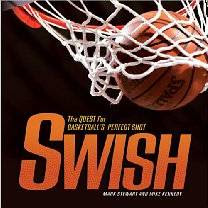
One of the sweetest sounds in the world is the SWISH a ball makes as it brushes against the thick cords of a basketball net.
And yet, as authors Stewart and Kennedy point out, except for a happenstance of history, that sound might have been a rattle or a thunk! When in 1891 YMCA instructor James Naismith was casting about for a vigorous indoor game to pass the long Massachusetts winter, he asked janitor Pop Stebbins for a crate or box to nail up on the goal post, but on short notice all Pop could come up with were two round wicker peach baskets, and, as we say, the rest is history.
Luckily, in a couple of years, the peach baskets were replaced with nets (how
did the first players get their balls back from those baskets?) and since that day, the urge to hear that satisfying "swish" has kept young men and women busy all winter perfecting that perfect shot. The authors point out that the game was an almost instant hit, even picking up female players right away, and soon youngsters all over the country were trying to become shooters.
Not a book on
how to shoot, but a history of the shot itself,
Swish: The Quest for Basketball's Perfect Shot (Exceptional Sports Titles for Intermediate Grades)
(Millbrook, 2009) is a lively and exciting account of basketball's long history, beginning with its first significant skill, the set shot. Long before defensive techniques developed, even before dribbling became the main means of moving the ball down court, the two-handed shooting stars like William "Pop" Gates of the Harlem Renaissance, the "Rens," were well-known "professional" players.
Chapter titles tell the story: Chapter II, "Buzzer Beaters" recounts those last ticks on the clock shots, from the
Sheboygan Redskins-
Fort Wayne Pistons final score in the old NBL wartime league in which Redskins center got off a last second hook shot which sank to win the game 29-27, to the
Bulls' Michael Jordan's twenty-foot jump ball to win beat the
Utah Jazz in 1998. The authors then go on to devote a chapter to the art of shooting--the set shot, one-hander, jump-shot (long, short, and mid-range), the driving shot, the (once-banned) slam dunk, bank shot, finger-roll, fadeaway, turnaround, and hook shot, not to mention the various styles of free-throw shots.
In Chapter IV the authors swing into the extreme--the "Longest, Shortest, Weirdest, Wildest" of basketball's remarkable history. Here's a sample from a game between the University of Chicago and the University of Pennsylvania in 1908:
During a scramble for a loose ball, Pat Page for Chicago grasped it with two hands but could not straighten up because of the Pennsylvania players surrounding him. He looked between his legs and saw an open teammate. Page "hiked" the ball like a football player. His desperate pass sailed over his teammate...and went right into the basket. Chicago won the game 21-18.
There are plenty more "extreme" shots, from Baron Davis' 89-foot shot in the NBA to the unbelievably lucky shot by a Clippers' dance team member, who, during a game break, sank her impromptu shot from 45 feet with her back to the basket!
Chapter V details the high-scoring stars of basketball--center Big George Mikan of the 1950s, one of pro basketball's first "big man" shooters, through Bob Pettit's high scoring feats of the 1960s, Chamberlain, Johnson, Jordan, and even 100-point games by collegians, Bevo Francis and Drank Selvy, and high schoolers Lisa Leslie and Cheryl Miller. The final chapter, "For the Record," provides pro scoring records for most points in a quarter, in a half, in a game, a season, and a a career, shooting percentages, averages per season, free throws, and three pointers. Women's pro records are given almost equal space, considering the comparatively short history of pro basketball for women--with the amazing season free-throw average of 98.4% for Eva Nemcova--a standout stat! With a short "Crystal Ball" chapter on basketball's future, the authors sink their shot with a solid bibliography of books and web sites and index.
A lively and engaging read,
Swish: The Quest for Basketball's Perfect Shot (Exceptional Sports Titles for Intermediate Grades)
will appeal to a variety of sport enthusiasts, from the would-be hot shooter to the nascent sports writer or historian or just the student looking for an agreeable nonfiction book report read.
This title is joined by a similar look at baseball's big hitters in
Long Ball: The Legend And Lore of the Home Run (Exceptional Social Studies Titles for Intermediate Grades)
in this promising nonfiction series.
Labels: Basketball--History (Grades 5-10)























